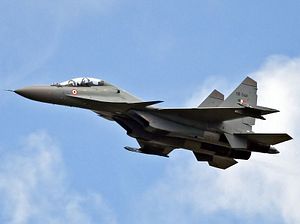The Indian Air Force (IAF) is slated to receive its first air-launched nuclear-capable BrahMos-A supersonic cruise missiles in January 2018, BrahMos Aerospace Joint Venture Co-Director Alexander Maxichev told TASS news agency at the Dubai Airshow 2017 on November 13.
“The Indian Air Force has signed a contract on the delivery of air-launched BrahMos cruise missiles from January 2018. The missiles are designed to arm about 50 Su-30MKI fighter aircraft modified for their use,” Maxichev said.
The deliveries will commence following the final tests of the missile against ground and naval targets. The test launches are expected to take place before the end of the year. The IAF has conducted several tests of the BrahMos-A in 2016 and 2017. So far, two of the service’s Sukhoi Su-30 MKI multirole air superiority fighter jets have been converted to accommodate the new cruise missile.
The BrahMos is a joint venture between India’s Defense Research Development Organization and Russian rocket design bureau NPO Mashinostroyeniya. The two-stage BrahMos missile—named after the Brahmaputra river in India and the Moskva river in Russia–is a derivative of the Russian P-800 Oniks over-the-horizon supersonic anti-ship cruise missile, which first entered service with the Indian Navy in 2006.
The missile “operates on a so-called fire and forget principle and can be dropped from 500 to 14,000 meters (1,640 to 46,000 feet), I explained elsewhere. “The missile’s terminal altitude is as low as ten meters. (The ship-launched anti-ship version of the BrahMos can fly 3-4 meters above the sea to avoid detection.) The BrahMos is capable of traveling at speeds of up to Mach 3.0, making it one of the world’s fastest cruise missiles.”
The Indian military has already inducted ground and naval launched variants of the BrahMos cruise missile. The air-launched version is lighter (2.55 tons) than other variants and features additional rear fins for aerodynamic stability. The missile’s range is estimated at around 290 kilometers (180 miles). (India recently also tested an extended-range variant of the missile.) With top speeds of Mach 2.8 to 3, the BrahMos is thought to be the world’s fastest cruise missile currently in service.
The BrahMos-A can alternatively be fitted with a 200-kilogram conventional or 300-kilogram nuclear warhead. In order for the Su-30 MKI to carry the heavyweight cruise missile its undercarriage had to be reinforced. Furthermore, the aircraft will also need to be fitted with hardened electronic circuitry to withstand the electromagnetic pulses of a nuclear blast.
A first flight test of a Sukhoi Su-30 MKI with a BrahMos-A took place in June 2016.
Given the size and weight of the BrahMos, the Su-30 MKI will only be capable of carrying one missile in a transport launch canister. “For the IAF this is the first time that a heavyweight supersonic cruise missile will be integrated with a long-range multi-role air superiority fighter jet,” I noted elsewhere.
The IAF will modify 50 Su-30MKI aircraft to carry the nuclear-capable cruise missile. The IAF new fleet of Dassault Rafale multirole fighter jets will also likely be retrofitted for the BrahMos-A. In total, the IAF is expected to receive 200 air-launched BrahMos-As in the coming years.

































